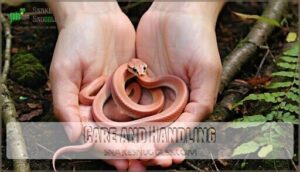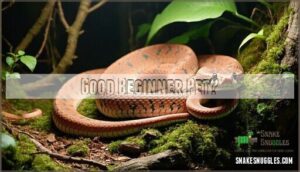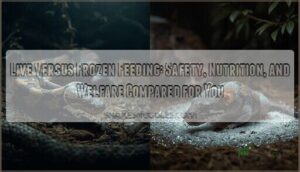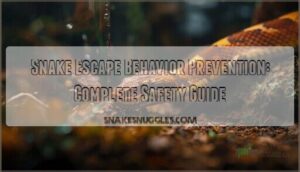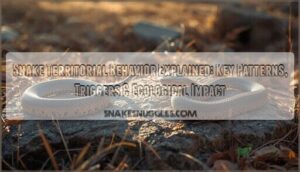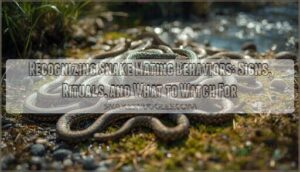This site is supported by our readers. We may earn a commission, at no cost to you, if you purchase through links.

You’ll find their care straightforward – they need a 20-gallon tank, simple heating setup, and frozen-thawed mice every 1-2 weeks. Unlike temperamental species, rosy boas forgive minor husbandry mistakes and adapt well to basic setups. Their calm nature makes handling stress-free, while their striking patterns provide visual appeal without the drama of more demanding snakes.
Initial costs run $300-700, with minimal annual expenses averaging just $20-30. However, understanding their specific temperature and humidity requirements becomes essential for preventing common health issues.
Table Of Contents
Key Takeaways
- You’ll find rosy boas are perfect starter snakes – they’re docile, rarely bite, and forgive beginner mistakes while requiring only basic care.
- You won’t need massive space or complicated setups – a 20-gallon tank with simple heating meets their needs, and they only eat every 1-2 weeks.
- You’re making a long-term commitment that’s surprisingly affordable – they live 20-30 years with minimal annual costs of just $20-30 after initial setup.
- You can handle them stress-free thanks to their calm temperament, making them ideal if you want an interactive pet without the drama of more demanding snake species.
Rosy Boa Facts — Size
You’ll find that adult rosy boas usually reach 22-35 inches in length, making them perfectly sized for home ownership without requiring massive enclosures.
Their compact, stocky build means you won’t need to worry about housing a snake that outgrows your space, unlike larger boa species that can exceed six feet.
Lifespan
When considering pet snakes, you’ll find rosy boas offer impressive longevity with proper care. These hardy reptiles usually live 20-30 years in captivity, considerably longer than their wild counterparts who average 15-20 years. Understanding the aging process and mortality rates helps guarantee responsible pet ownership throughout their extended life expectancy.
Rosy boas reward committed owners with an exceptional 20-30 year lifespan in captivity
- Reach sexual maturity between 2-3 years of age
- Gestation period ranges from 103-143 days for breeding females
- Give live birth to litters of 1-14 offspring per cycle
Longevity factors include proper nutrition, controlled temperatures, and preventive reptile health measures that reduce common health risks affecting boa lifespan.
Diet
Your rosy boa thrives on a carnivorous diet of frozen and thawed mice. Feed juveniles every 5-7 days and adults every 10-14 days. Choose prey items equal to your snake’s widest body section for ideal nutrient requirements. These aggressive feeders benefit from consistent feeding habits to maintain healthy growth. Proper reptile care guidelines are essential for their well-being.
| Age Group | Meal Frequency | Food Sources |
|---|---|---|
| Juveniles | 5-7 days | Pinky mice, fuzzy mice |
| Adults | 10-14 days | Adult mice, small rats |
| Supplemental | Occasional | Day-old chicks |
Enclosure and Habitat
You’ll need to provide proper housing that meets your rosy boa’s physiological requirements for thermoregulation and security.
A well-designed enclosure with appropriate substrate, temperature gradients, and hiding spots creates the foundation for your snake’s long-term health and behavioral well-being.
Size Requirements
Your rosy boa needs proper tank dimensions to thrive. A 20-gallon long tank works for adults, though a 40-gallon breeder tank offers better space needs. Housing options should accommodate their 24-36 inch adult length with secure lids preventing escapes. Snake enclosure setup requires length over height since they’re terrestrial.
- Tank requirements: 40-gallon breeder tanks provide ideal floor space for adult movement
- Habitat setup: Length matters more than height – prioritize horizontal enclosure size over vertical space
- Size variations: Coastal subspecies may need slightly larger housing options than desert varieties
Substrate & Décor
Creating the perfect habitat setup requires smart substrate options and strategic tank decorations. Choose sandy soil blends or aspen bedding for proper burrowing, maintaining humidity levels below 60%.
Install multiple hide boxes at different temperature zones with sturdy basking spots. Your rosy boa’s habitat setup should include secure rocks and branches while avoiding moisture-retaining materials that compromise enclosure health.
To achieve a naturalistic environment, consider incorporating rock crevices that mimic the snake’s natural habitat.
Care and Handling
You’ll find that proper care and handling techniques are essential for maintaining your rosy boa’s health and developing a trusting relationship with your pet.
These docile snakes respond well to consistent feeding schedules and gentle handling practices, which we’ll cover in the feeding and temperament sections below.
Feeding
Your snake’s appetite tells you everything about its health and happiness. Young rosy boas need weekly meals of appropriately-sized frozen-thawed prey, from pinkies to hoppers based on their growth stage. Adults thrive on larger whole prey items every 7-10 days, with frozen-thawed prey being safer than live prey. Monitor your boa’s body condition closely to adjust meal frequency and prey selection accordingly.
Feeding Techniques for Success:
- Offer prey using feeding tongs to prevent accidental bites
- Feed in a separate container to reduce substrate ingestion
- Allow 24-48 hours of undisturbed digestion after meals
- Supplement with calcium powder monthly for ideal nutrient requirements
Temperament
Patience rewards rosy boa owners with a remarkably docile temperament and mild-mannered behavior. These snakes demonstrate interactive behavior through calm responses to proper handling techniques.
Their docile nature makes them ideal for beginner reptile owners seeking predictable pet snake ownership experiences. With consistent rosy boa care, you’ll discover snake personality traits that emphasize gentle, non-aggressive interactions during regular handling sessions.
Good Beginner Pet?
If you’re considering your first snake, rosy boas earn their reputation as outstanding beginner reptiles. These California natives combine manageable care requirements with forgiving temperaments that won’t overwhelm new keepers. Beginner reptile owners appreciate their predictable snake behavior and straightforward care basics, making the shift into reptile ownership smooth and rewarding.
Three key advantages make rosy boas perfect starter snakes:
- Docile temperament – They rarely bite and tolerate handling well, reducing stress for nervous beginners.
- Compact size – Adults reach only 2-3 feet, requiring modest 20-gallon enclosures that fit any home.
- Hardy constitution – They forgive minor care mistakes that might stress more sensitive species.
While beginner challenges exist (like finding a responsible breeder and mastering feeding techniques), rosy boas remain remarkably pet friendly. Their calm nature makes handling tips easier to implement, and their straightforward needs create an ideal learning environment. This beginner pet guide wouldn’t be complete without emphasizing their forgiving nature – they’ll give you room to grow as a keeper while providing years of rewarding companionship.
Appearance Varieties
Rosy Boa color morphs showcase outstanding diversity that’ll captivate any reptile enthusiast. These snakes display stunning pattern variations ranging from classic tri-striped designs to solid colorations. Desert Rosy Boas usually exhibit earthy tones—browns, grays, and tans—while Coastal Rosy Boas feature vibrant oranges, reds, and rose hues. Scale types remain consistent across morphs, but belly colors vary from cream to pink.
Popular varieties include albino morphs lacking dark pigmentation, banded patterns with distinct crossbars, and patternless specimens showing uniform coloration. Lichanura trivirgata demonstrates impressive genetic diversity through selective breeding programs. Morph genetics continue evolving as breeders develop new color and pattern varieties, making each Rosy Boa unique in appearance.
Cost of Ownership
Before diving into exotic pet ownership, understanding the financial commitment helps you make an informed decision. Rosy boas represent one of the more affordable reptilian companions, but the initial investment and ongoing expenses still require careful budgeting.
Your startup costs usually range from $300-700, covering the snake ($25-600 depending on morph), enclosure setup ($50-200), and essential equipment.
Here’s what you’ll spend annually:
- Food Budget: $30-50 yearly for feeder mice (adult boas eat 2-3 mice monthly)
- Veterinary Costs: $100+ for routine exotic pet checkups, with emergencies potentially reaching $500
- Maintenance Fees: $20-40 for substrate replacement and equipment upgrades
- Utilities: $15-30 annually for heating and lighting
Monthly ownership costs average $20-30, substantially less than traditional pets like dogs or cats. A responsible pet breeder can provide guidance on budgeting for your pet snake’s 20+ year lifespan.
Health and Common Issues
Throughout their impressive 30-year lifespan, rosy boas face several predictable Snake Health Issues that proper Reptile Health management can prevent. Respiratory infections develop when enclosures become too cool and humid, causing wheezing and mouth-breathing that requires immediate Veterinary Care. Mites and internal parasites represent common concerns, making Parasite Control essential through quarantine protocols and regular Health Checks.
Scale rot emerges from overly humid conditions, while shedding difficulties indicate dehydration or inadequate humidity during molting cycles. Inclusion Body Disease poses the most serious threat—this contagious, incurable condition demands strict Disease Prevention through quarantine and sanitation. Digestive issues like regurgitation often signal stress, overfeeding, or parasites.
Maintaining proper temperatures, humidity levels, and cleanliness forms the cornerstone of effective Pet Snake Care. Annual fecal examinations and wellness visits guarantee early detection of problems, keeping your rosy boa healthy throughout their remarkably long life.
Finding a Responsible Breeder
Successfully finding a responsible breeder requires thorough research and careful evaluation. Responsible pet breeding practices guarantee you’ll receive a healthy rosy boa with proper genetic lineage and veterinary care.
Start by connecting with local reptile enthusiasts through herpetological societies or reptile shows, where experienced pet owners often share breeder recommendations.
When evaluating potential breeders, prioritize these essential criteria:
- Breeding Ethics Documentation – Request health records, snake pedigree information, and proof of reptile certification or licensing
- Facility Transparency – Responsible breeders welcome facility visits and openly discuss their husbandry practices
- Long-term Support – Quality breeders offer health guarantees and remain available for ongoing guidance
Breeder research should include verifying their reputation within the reptile community and examining their animals for signs of proper socialization. Responsible ownership begins with choosing breeders who prioritize animal welfare over profit margins. While reputable breeders usually charge more, this investment guarantees you’re supporting ethical practices while acquiring a well-adjusted pet.
Avoid impulse purchases from pet stores or unverified online sources, as these often lack proper documentation and health screening protocols.
Frequently Asked Questions (FAQs)
What are some recommended enclosure accessories and substrates for rosy boas?
You’ll need aspen shavings, coconut coir, or cypress mulch as substrate—avoid sand, cedar, or pine. Add stacked rocks, branches, and hiding spots for enrichment and basking opportunities.
Do rosy boas bite humans frequently?
Like gentle giants of the snake world, rosy boas rarely bite humans. They’re extremely docile and not prone to defensive biting.
Any bites usually result from food-related confusion rather than aggression.
Can rosy boas live with other snakes?
No, you shouldn’t house rosy boas together. They’re solitary creatures who’ll compete for resources, cause stress, and risk disease transmission.
Cohabitation can lead to aggression, injuries, and feeding problems. Keep them separately for their wellbeing.
Are rosy boas legal in all states?
Rosy boa legality varies substantially by state. You’ll find they’re generally legal in most states since they’re nonvenomous, native species. However, some states require permits or have restrictions on collecting wild specimens.
How often do rosy boas shed skin?
Your snake will shed approximately every 4-8 weeks, depending on age and growth rate. Juveniles shed more frequently than adults since they’re growing rapidly.
You’ll notice milky eyes and dull skin before shedding begins.
Do rosy boas need special lighting cycles?
Your scaly companion doesn’t need complicated lighting arrangements, though a gentle day-night cycle helps maintain natural rhythms.
UVB lighting isn’t essential, but consistent 12-hour light cycles support healthy behavior patterns and feeding responses.
Conclusion
Like finding the perfect starter car, rosy boas offer reliability without complexity. These hardy serpents consistently prove that rosy boas are good pets for reptile enthusiasts at any experience level.
Their forgiving nature, minimal space requirements, and predictable care routine make them ideal first snakes. You’ll appreciate their 20-30 year companionship, straightforward feeding schedule, and gentle temperament.
With proper setup and basic husbandry knowledge, you’ll discover why rosy boas remain top choices for successful snake ownership experiences.
- https://animaldiversity.org/accounts/Charina_trivirgata/
- https://reptizoo.store/blogs/reptizoo-reptiles-blogs/rosy-boa-care-sheet-2024
- https://www.idahofallsidaho.gov/DocumentCenter/View/15606/Rosy-Boa
- https://www.untamedathome.com/our-blog/rosy-boa-vs-corn-snake-which-is-better-for-beginners
- https://www.snakeestate.com/boa-constrictors/desert-rosy-boa/


